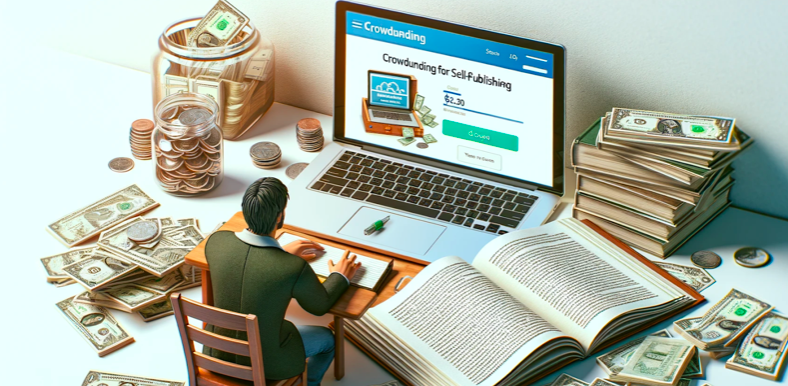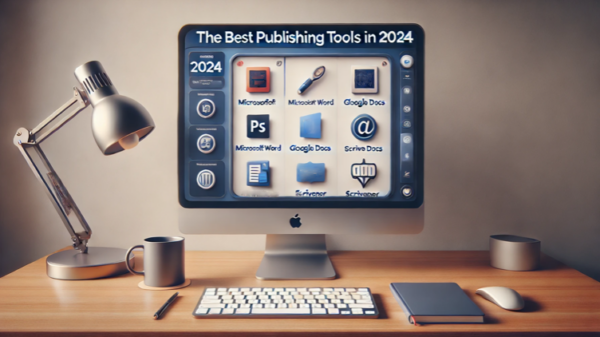Crowdfunding has emerged as a revolutionary way for authors to finance their self-publishing projects. By leveraging the power of online platforms, writers can raise funds directly from readers and supporters, bypassing the traditional gatekeepers in the publishing industry. This method not only provides the financial backing needed to publish a book but also helps authors gauge interest and build an audience before the book is even released.
In recent years, there has been a noticeable uptick in successful crowdfunding campaigns for books, with numerous authors securing the necessary funds to bring their projects to life. These success stories highlight the potential of crowdfunding to democratize the publishing process and empower writers of all genres.
This guide is essential for aspiring authors who want to explore crowdfunding as a viable option for self-publishing. It will provide comprehensive insights into the process, tips for creating a successful campaign, and an overview of the best platforms to use.
What is Crowdfunding for Self-Publishing?
Crowdfunding is a method of raising funds for a project or venture by collecting small amounts of money from a large number of people, typically via the Internet. In the context of self-publishing, crowdfunding allows authors to pitch their book ideas to potential readers and supporters who then pledge financial contributions to help bring the project to fruition. This process not only provides the necessary capital to cover production costs such as editing, cover design, and printing but also serves as a marketing tool to build anticipation and a reader base before the book is even published.
Explanation of Crowdfunding and Its Application to Self-Publishing
In a crowdfunding campaign for a book, authors create a project page on a crowdfunding platform detailing their book idea, target fundraising goal, and the incentives or rewards backers will receive for their support. These rewards can range from a signed copy of the book to exclusive content or acknowledgments in the book itself. By sharing their campaign through social media, email lists, and other channels, authors can reach a wide audience and encourage them to support their project.
Differences Between Crowdfunding and Traditional Publishing
Traditional publishing typically involves submitting a manuscript to a publishing house, which then takes on the financial risk of producing and distributing the book. The publisher handles all aspects of the publishing process, including editing, design, marketing, and distribution, in exchange for a significant share of the book’s profits and creative control over the final product. This route often involves numerous rejections and long waiting periods.
In contrast, crowdfunding for self-publishing empowers authors to retain creative control and ownership of their work. It eliminates the need for an intermediary, allowing authors to interact directly with their readers. This direct connection not only helps in funding the project but also creates a loyal readership that feels personally invested in the book’s success.
Your Publishing Journey Awaits – Start NowBenefits of Crowdfunding
Crowdfunding mitigates the financial risk associated with self-publishing. Instead of investing their own money upfront, authors can use the funds raised through their campaign to cover production costs. This approach reduces the financial burden and allows authors to gauge market interest before committing to large-scale production.
One of the most significant advantages of crowdfunding is the direct engagement it fosters between authors and readers. This interaction helps authors build a dedicated audience and receive feedback during the creation process. By involving readers early on, authors can create a sense of community and loyalty that often translates into better book sales and word-of-mouth promotion.
Crowdfunding for self-publishing offers a unique blend of financial support and reader engagement, making it an attractive option for authors looking to publish their work independently and build their self-publishing team.
The Self-Publishing Journey
Self-publishing is the process by which authors publish their books independently, without the involvement of a traditional publishing house. This route allows authors to maintain full control over their work, from writing and editing to design, marketing, and distribution.
Steps Involved in Self-Publishing
1. Writing and Editing: The journey begins with the writing of the manuscript. Once the initial draft is completed, it undergoes several rounds of editing—structural, copyediting, and proofreading—to ensure the highest quality.
2. Cover Design and Formatting: The next step involves designing an attractive book cover and formatting the manuscript for both print and digital versions. This includes choosing fonts, setting margins, and ensuring the layout is professional.
3. Publishing and Distribution: Authors then choose a platform for publishing their book. Popular options include Amazon Kindle Direct Publishing (KDP), IngramSpark, and Barnes & Noble Press. These platforms handle the printing and distribution of both physical and digital copies.
4. Marketing and Promotion: Successful self-publishing requires effective marketing strategies. Authors use social media, book trailers, blogs, email newsletters, and other tools to promote their book. Engaging with readers through these channels is crucial for building a fan base.
5. Sales and Royalties: After publication, authors monitor sales and earnings. Self-published authors typically receive higher royalties compared to traditional publishing, but they also bear the responsibility of continuous marketing to maintain sales momentum.
Comparison with Traditional Publishing
In traditional publishing, authors submit their manuscripts to publishing houses, which handle all aspects of the publishing process, including editing, design, marketing, and distribution. While this can be advantageous in terms of professional support and wider distribution channels, it often involves relinquishing creative control and a significant portion of the book’s profits. Traditional publishing also typically requires navigating a lengthy and competitive submission process.
Self-publishing, on the other hand, allows authors to retain full creative control and receive higher royalties. However, it requires the author to take on multiple roles, including marketer and project manager and often involves upfront costs.
Why Choose Self-Publishing?
One of the main reasons authors choose self-publishing is the complete creative control it offers. Authors can make all decisions regarding their book’s content, design, and marketing strategies. This autonomy allows them to stay true to their vision without external interference. Additionally, self-published authors typically earn higher royalties, as they do not have to share profits with a publishing house.
Self-publishing also provides flexibility in terms of timeline and process. Authors can set their own deadlines and release schedules, allowing for a faster publication process compared to the traditional route. This flexibility is particularly beneficial for authors who want to respond quickly to market trends or who have multiple projects in the pipeline.
The self-publishing journey is a comprehensive process that requires authors to wear many hats. However, the benefits of creative control, higher royalties, and flexibility make it an appealing option for many writers looking to bring their work directly to readers.
Understanding the Publishing Process
The journey from manuscript to published book involves several critical steps, each requiring careful attention and effort to ensure a professional final product.
Writing, Editing, and Cover Design
1. Writing: The foundation of any book is its content. This stage involves drafting the manuscript, which can take months or even years, depending on the complexity of the project and the writer’s pace.
2. Editing: Once the manuscript is complete, it undergoes multiple rounds of editing. Structural or developmental editing focuses on the overall narrative, character development, and pacing. Copyediting addresses grammar, style, and consistency, while proofreading catches any remaining errors. Professional editors are essential at this stage to ensure the manuscript meets industry standards.
3. Cover Design: The book’s cover is often the first thing potential readers notice, making it a crucial element in the publishing process. A compelling cover design can attract readers and convey the essence of the book. Professional cover designers can help create visually appealing and market-appropriate designs.
Formatting and Distribution
4. Formatting: Proper formatting is necessary for both print and digital versions. This includes setting the correct margins, fonts, and layouts for a polished, readable book. For eBooks, it also involves ensuring compatibility with various devices and platforms.
5. Distribution: Once the book is formatted, it needs to be distributed. Platforms like Amazon Kindle Direct Publishing (KDP), IngramSpark, and others provide the infrastructure to distribute both print and digital copies worldwide. Authors must decide whether to distribute exclusively through one platform or multiple channels to reach a broader audience.
Your Publishing Journey Awaits – Start NowChallenges in the Publishing Process
One of the primary challenges in the publishing process is the financial burden. Costs associated with professional editing, cover design, and marketing can add up quickly. Many self-published authors struggle to cover these expenses, which is why securing funding is crucial. Crowdfunding can be an effective way to raise the necessary funds, allowing authors to produce high-quality books without incurring personal debt.
Even with a well-written and beautifully designed book, reaching the target audience can be challenging. The market is saturated with countless books, making it difficult to stand out. Effective marketing strategies are essential to attract readers. This includes building a robust online presence, engaging with potential readers through social media and email newsletters, and leveraging book reviews and endorsements.
Marketing efforts must be sustained over time to maintain visibility and drive sales. Many self-published authors find this aspect particularly daunting, as it requires continuous effort and creativity. Understanding the target audience and tailoring marketing efforts to their preferences can significantly enhance a book’s success.
The publishing process involves meticulous planning and execution across several stages, from writing and editing to design, formatting, and distribution. While financial and marketing challenges exist, strategic planning and the use of available resources can help authors overcome these hurdles and achieve successful self-publication.
Raising Funds through Crowdfunding
Determining the financial needs of your book project is the first step in setting a successful crowdfunding goal. Start by listing all potential expenses, which typically include:
1. Editing: Costs for structural editing, copyediting, and proofreading can vary, but it’s essential to hire professional editors to ensure the quality of your book.
2. Cover Design: A professionally designed cover is crucial for attracting readers. Include the cost of hiring a graphic designer.
3. Formatting: Budget for formatting services for both print and digital versions to ensure your book looks professional across all formats.
4. Printing and Distribution: If you plan to offer physical copies, calculate the costs of printing and shipping.
5. Marketing and Promotion: Allocate funds for marketing efforts, including social media ads, book trailers, and promotional materials.
6. Rewards for Backers: If you plan to offer rewards such as signed copies, exclusive content, or merchandise, include these costs in your budget.
By itemizing these costs, you can develop a clear understanding of your total financial needs. It’s also wise to add a buffer for unexpected expenses.
Importance of a Realistic and Achievable Goal
Setting a realistic and achievable fundraising goal is crucial for the success of your crowdfunding campaign. Aim too high, and you risk not reaching your goal and receiving no funds at all (in the case of all-or-nothing platforms like Kickstarter). Aim too low, and you may not raise enough to cover your costs.
To set an appropriate goal:
- Research Similar Campaigns: Look at successful book crowdfunding campaigns to gauge typical funding amounts.
- Be Transparent: Clearly explain how the funds will be used. Transparency builds trust with potential backers.
- Consider Your Network: Assess the size and engagement level of your existing audience. A strong, supportive network can significantly impact your campaign’s success.
Creating a Solid Plan
A well-planned campaign with clearly defined milestones can keep you on track and maintain momentum. Key steps include:
1. Pre-Launch Preparation: Build anticipation before launching your campaign by teasing your project on social media, engaging with potential backers, and creating a mailing list.
2. Campaign Launch: Choose a strategic launch date and time. Consider running your campaign for 30-45 days to maintain urgency while giving yourself enough time to reach your goal.
3. Mid-Campaign Engagement: Keep your audience engaged with regular updates, new rewards, and stretch goals. This can help maintain interest and attract new backers.
4. Final Push: Intensify your promotional efforts as the campaign nears its end to capture any last-minute contributions.
Strategies for Effective Budgeting
Effective budgeting ensures that you use your funds wisely and can fulfill your promises to backers. Strategies include:
- Detailed Cost Breakdown: Provide a detailed breakdown of how every dollar will be spent. This not only helps you stay on budget but also reassures backers of your financial responsibility.
- Prioritize Expenses: Identify essential costs and prioritize them in your budget. This helps you allocate funds effectively and make informed decisions if you need to cut costs.
- Monitor Spending: Keep track of your expenses throughout the campaign and adjust your budget as needed. Regular monitoring helps prevent overspending and ensures you stay within your financial limits.
By setting a realistic goal, creating a detailed plan, and implementing effective budgeting strategies, you can increase your chances of running a successful crowdfunding campaign and securing the funds needed to bring your book project to life.
Your Publishing Journey Awaits – Start NowChoosing the Right Crowdfunding Sites
When selecting a crowdfunding platform for your book project, it’s essential to consider the most popular and widely-used options. The following platforms are known for their extensive reach and user-friendly features, making them ideal for self-publishing authors:
1. Kickstarter: Kickstarter is one of the most well-known crowdfunding platforms, offering a broad audience and a well-established reputation. It operates on an all-or-nothing funding model, meaning you only receive funds if you meet your goal.
2. Indiegogo: Indiegogo offers more flexibility than Kickstarter, with both all-or-nothing and flexible funding options. This allows you to keep the funds raised even if you don’t meet your initial goal.
3. GoFundMe: While not specifically designed for creative projects, GoFundMe is another popular platform that allows for flexible funding. It’s known for its ease of use and broad appeal, though it might lack the specific audience interested in books.
Pros and Cons of Each Platform
Kickstarter
- Pros: Large user base, established reputation, all-or-nothing model creates urgency, strong community support.
- Cons: The all-or-nothing model can be risky if you don’t reach your goal, higher competition among projects.
Indiegogo
- Pros: Flexible funding option, extensive reach, additional marketing tools, InDemand feature for continued fundraising post-campaign.
- Cons: Fees can be higher than Kickstarter, and there is less community focus on books specifically.
GoFundMe
- Pros: Simple setup, flexible funding, wide audience.
- Cons: Not specifically geared towards creative projects, less community engagement for book campaigns.
Other Platforms Specifically Designed for Books
For authors seeking platforms tailored specifically to book projects, several niche crowdfunding sites offer targeted benefits:
1. Unbound: Unbound is a UK-based platform that combines crowdfunding with traditional publishing elements. It offers editorial support and distribution channels, making it a hybrid model that can be appealing for authors looking for additional publishing support.
2. Publishizer: Publishizer connects authors with publishers through crowdfunding. It allows authors to gather pre-orders and pitch to traditional publishers simultaneously, offering a unique blend of crowdfunding and traditional publishing benefits.
3. Inkshares: Inkshares is a platform where readers fund books they want to read. It operates with a community-driven approach, and successful campaigns receive full publishing and distribution services.
Their Benefits
Unbound
- Pros: Editorial and marketing support, access to traditional distribution, hybrid model provides more resources.
- Cons: Limited to certain geographical regions, higher entry barrier.
Publishizer
- Pros: Opportunity to pitch to publishers, combines pre-ordering with crowdfunding, and the potential for a traditional publishing deal.
- Cons: Platform fees, requires strong proposal and marketing efforts.
Inkshares
- Pros: Community-driven, full publishing services, engaged readership.
- Cons: High competition, and platform fees.
Examples of Successful Campaigns on These Platforms
Unbound: “The Good Immigrant,” a collection of essays by immigrant writers in the UK, raised significant funds and garnered widespread attention, illustrating the platform’s strength in promoting diverse voices.
Publishizer: “The 7 Graces of Marketing” by Lynn Serafinn successfully used Publishizer to attract a publisher and gain a wide readership, demonstrating the platform’s effectiveness in bridging crowdfunding with traditional publishing.
Inkshares: “The Punch Escrow” by Tal M. Klein was successfully funded on Inkshares and went on to receive critical acclaim and commercial success, highlighting the platform’s ability to identify and support promising projects.
By choosing the right crowdfunding platform, authors can significantly enhance their chances of a successful campaign, ensuring they secure the necessary funds while building a dedicated reader base.
Crafting a Successful Crowdfunding Campaign
Creating a compelling campaign page is crucial for attracting and convincing backers to support your book project. Key elements to focus on include your story, visuals, and rewards.
Key Elements: Story, Visuals, and Rewards
1. Story: Your campaign story should explain why your book is unique and why it matters. Share the inspiration behind your book, your writing journey, and the impact you hope to achieve. Be authentic and passionate, as genuine stories resonate with potential backers.
2. Visuals: High-quality visuals can significantly enhance your campaign page. Use professional images of your book cover, illustrations, and photos of yourself. Consider creating a short video where you introduce yourself and your project, as videos can increase engagement and trust.
3. Rewards: Clearly outline the rewards backers will receive for their support. Ensure that the rewards are desirable and appropriately tiered to encourage higher contributions.
Tips for Writing an Engaging Campaign Description
- Start Strong: Begin with a compelling hook that grabs attention. Explain what your book is about and why it’s important.
- Be Clear and Concise: Avoid lengthy paragraphs and jargon. Use bullet points and subheadings to break up text and make it easy to read.
- Showcase Your Passion: Convey your enthusiasm and commitment to your project. Passionate language can inspire potential backers.
- Include Social Proof: If you have endorsements, positive reviews, or previous successful projects, highlight them to build credibility.
- Call to Action: Encourage readers to back your project and share it with their networks. Make it easy for them to take action.
Offering Rewards
Offering attractive rewards is a key strategy in motivating backers to support your campaign. Rewards should be meaningful, varied, and aligned with your book’s theme and audience.
Types of Rewards
1. Signed Copies: Autographed books are a popular and personal reward.
2. Exclusive Content: Offer backers special content, such as behind-the-scenes looks, bonus chapters, or early access to your next project.
3. Merchandise: Branded items like bookmarks, posters, or tote bags can be appealing.
4. Acknowledgments: Thank backers by including their names in the book’s acknowledgment section.
5. Limited Editions: Create limited edition prints or hardcover versions of your book.
How to Make Rewards Appealing to Backers
1. Align Rewards with Interests: Ensure rewards resonate with your target audience. For example, offer literary-themed items for book lovers.
2. Create Tiers: Offer rewards at different contribution levels. Lower tiers might include digital copies or thank-you notes, while higher tiers could feature personalized items or exclusive experiences.
3. Be Realistic: Make sure you can deliver on all promised rewards. Factor in production and shipping costs when setting contribution levels.
4. Offer Unique Experiences: Personal experiences, like virtual book readings or writing workshops, can be highly appealing and create a deeper connection with your backers.
5. Provide Value: Ensure that the perceived value of the reward matches the contribution level. Backers should feel they are getting something worthwhile in return for their support.
By focusing on these elements and strategies, you can craft a crowdfunding campaign that not only attracts backers but also builds a community around your book project. A compelling story, engaging visuals, and appealing rewards are the foundation of a successful campaign page, helping you reach your funding goals and bring your book to life.
Your Publishing Journey Awaits – Start NowEngaging Your Audience
Effective marketing is crucial for the success of your crowdfunding campaign. Utilizing social media and email marketing can significantly boost your campaign’s visibility and reach.
Using Social Media and Email Marketing
1. Social Media: Platforms like Facebook, Twitter, Instagram, and LinkedIn are powerful tools for promoting your campaign. Create engaging posts that highlight different aspects of your book project. Use images, videos, and stories to capture attention and maintain interest. Regularly update your followers on the campaign’s progress and milestones. Utilize hashtags relevant to your book’s genre and crowdfunding to reach a broader audience.
2. Email Marketing: Build and maintain an email list of potential backers. Send out newsletters that provide updates on your campaign, share behind-the-scenes content, and offer exclusive previews. Personalized emails can make recipients feel valued and more likely to support your project. Include clear calls to action and links to your campaign page in every email.
Engaging with Your Existing Audience and Expanding Reach
1. Leverage Existing Audience: Your current followers are your most accessible supporters. Engage them by asking for feedback, sharing exclusive content, and encouraging them to spread the word about your campaign. Personal appeals can be particularly effective.
2. Expand Your Reach: Collaborate with influencers and bloggers in your book’s genre. Guest posts, interviews, and social media takeovers can introduce your project to new audiences. Participate in online communities and forums related to your book’s topic to connect with potential backers.
Building Relationships with Backers
Developing strong relationships with your backers is essential for the long-term success of your project. Effective communication and community-building efforts can turn one-time backers into lifelong supporters.
Communicating Effectively and Providing Updates
1. Regular Updates: Keep your backers informed with regular updates on your campaign’s progress. Share milestones, challenges, and successes. Transparency builds trust and keeps backers engaged. Use a mix of text, images, and videos to keep updates interesting.
2. Prompt Responses: Respond to questions, comments, and messages from backers promptly. Acknowledging their contributions and showing appreciation fosters a positive relationship. Use platforms like Kickstarter’s update feature or dedicated social media channels to facilitate easy communication.
Creating a Community Around Your Book Project
1. Interactive Content: Create opportunities for backers to interact with you and each other. Host Q&A sessions, live streams, or virtual book readings. Encourage discussions about your book’s themes or characters. This interaction can deepen backers’ investment in your project.
2. Exclusive Groups: Consider creating a private group or forum for your backers. This space can serve as a community hub where backers can share their excitement, provide feedback, and feel like part of an exclusive club. Platforms like Facebook Groups or Discord are excellent for fostering community.
3. Recognition and Gratitude: Publicly acknowledge your backers’ support. Feature them in your updates, social media posts, and even within the book itself. This recognition can enhance their sense of involvement and loyalty.
By effectively marketing your campaign and building strong relationships with your backers, you can create a supportive community around your book project. This community not only helps you achieve your crowdfunding goals but also provides a solid foundation for future projects and long-term success as an author.
Managing and Completing the Campaign
Monitoring your campaign’s progress is vital to ensure you stay on track to meet your fundraising goal. Use the analytics tools provided by your crowdfunding platform to track key metrics such as the number of backers, funds raised, and the effectiveness of your promotional efforts.
1. Daily Checks: Review your campaign’s performance daily. Pay attention to the spikes in pledges, which can help you understand what promotional activities or updates are driving contributions.
2. Adjust Strategies: If you notice that your campaign is slowing down or not meeting milestones, be prepared to adjust your strategies. This might include increasing your marketing efforts, introducing new rewards, or enhancing your social media outreach.
3. Engage Backers: Regularly engage with your backers through updates and direct messages. Share your progress, celebrate milestones, and ask for feedback. This keeps backers involved and invested in the success of your project.
Keeping Backers Informed and Involved
1. Frequent Updates: Keep your backers informed with frequent updates about the campaign’s progress. Highlight significant milestones and any changes to the campaign. Transparency builds trust and maintains enthusiasm.
2. Interactive Engagement: Encourage backers to share their thoughts and ideas. This can be done through comments, polls, or direct messages. Making backers feel involved can foster a sense of community and ownership.
Post-Campaign Step
1. Organize Logistics: Once the campaign is complete, organize the logistics for fulfilling rewards. This includes ordering the necessary materials, such as printed books and merchandise, and planning the shipping process.
2. Communicate Timelines: Clearly communicate expected timelines for reward fulfillment to your backers. Keep them updated on any delays or issues that arise.
3. Quality Assurance: Ensure all rewards are of high quality and meet the expectations set during the campaign. This maintains credibility and backer satisfaction.
Continuing Engagement and Building Long-Term Relationships with Readers
1. Stay Connected: After the campaign ends, continue to engage with your backers. Send regular updates about the book’s progress, release dates, and any upcoming projects. Social media, email newsletters, and dedicated groups are excellent for ongoing communication.
2. Express Gratitude: Show appreciation to your backers through thank-you notes, special mentions in your book, or exclusive content. Gratitude can strengthen your relationship with your supporters.
3. Involve Backers in Future Projects: Invite your backers to be part of your future projects. Offer them early access, special previews, or the opportunity to provide input on new ideas. This can turn one-time backers into lifelong fans and supporters.
By monitoring progress, keeping backers informed, and fulfilling rewards efficiently, you can successfully manage and complete your crowdfunding campaign. Continuing to engage with your backers post-campaign helps build lasting relationships, creating a loyal reader base for future projects.
Conclusion
Crowdfunding offers a powerful avenue for aspiring authors to bring their self-publishing dreams to life. By setting a realistic fundraising goal, choosing the right platform, crafting a compelling campaign page, and engaging with potential backers, authors can secure the financial support needed to produce and market their books. Throughout the process, effective communication and relationship-building with backers are crucial for maintaining momentum and achieving success.
For those considering this path, remember that crowdfunding is not just about raising funds; it’s about building a community around your book project. This community can provide invaluable support and feedback, enhancing your journey as an author.
Take the first step with confidence—whether you are writing fiction, nonfiction, or an art book, crowdfunding can democratize the publishing process, giving you the creative control and financial backing to make your book a reality. Embrace the potential of crowdfunding and start your self-publishing journey today.
Have you completed your manuscript and are ready to share it with the world? Spines stands as your gateway to the publishing realm, embodying the future of publishing. Our AI-powered platform is designed to revolutionize your publishing journey, offering a suite of comprehensive services. These include detailed editing and proofreading, captivating cover creation, seamless distribution, and strategic marketing across various channels and platforms. With Spines, your book is not only set to transcend the ordinary but also to make a significant impact in the new era of publishing. Sign up for free to start your self-publishing journey.
Your Publishing Journey Awaits – Start Now







